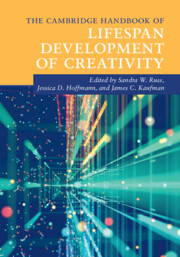Book contents
- The Cambridge Handbook of Lifespan Development of Creativity
- The Cambridge Handbook of Lifespan Development of Creativity
- Copyright page
- Dedication
- Contents
- Figures
- Tables
- Contributors
- Acknowledgments
- Introduction
- Part I Core Concepts of Lifespan Creativity Development
- Part II The Development of Creativity
- Part III Modes of Enhancement
- 12 Domain-Specific Talent Development
- 13 Enhancement of Creativity across the Lifespan in Mainland China
- 14 Beyond Flights of Fancy?
- 15 Creating Imaginary Worlds across the Lifespan
- 16 Imaginative Creativity in the Writing and Reading of Stories
- 17 The Effects of Video Games on Creativity
- Part IV Environments and Contexts
- Part V Special Populations
- Index
- References
14 - Beyond Flights of Fancy?
The Relations between Children’s Imaginary Companions, Creativity, and Coping
from Part III - Modes of Enhancement
Published online by Cambridge University Press: 19 November 2021
- The Cambridge Handbook of Lifespan Development of Creativity
- The Cambridge Handbook of Lifespan Development of Creativity
- Copyright page
- Dedication
- Contents
- Figures
- Tables
- Contributors
- Acknowledgments
- Introduction
- Part I Core Concepts of Lifespan Creativity Development
- Part II The Development of Creativity
- Part III Modes of Enhancement
- 12 Domain-Specific Talent Development
- 13 Enhancement of Creativity across the Lifespan in Mainland China
- 14 Beyond Flights of Fancy?
- 15 Creating Imaginary Worlds across the Lifespan
- 16 Imaginative Creativity in the Writing and Reading of Stories
- 17 The Effects of Video Games on Creativity
- Part IV Environments and Contexts
- Part V Special Populations
- Index
- References
Summary
Both past and current research indicates that the creation of an imaginary companion is a common, normative, and healthy form of elaborated role-play that emerges in early childhood. Imaginary companions are often the invisible friends that children create for themselves, or the special stuffed animals or dolls that children imbue with personalities. Children often describe and experience their imaginary companions in ways that parallel real friendships with peers. Their emotional investment in these invented characters raises important questions about the broader roles they serve in their lives. Current research in this area has focused on the developmental significance of imaginary companions, and the extent to which they might have a real and meaningful impact on children’s development. This chapter reviews the extant literature on imaginary companions, with a particular focus on the relations between children’s imaginary companions, creativity, and coping with adversity.
- Type
- Chapter
- Information
- The Cambridge Handbook of Lifespan Development of Creativity , pp. 305 - 326Publisher: Cambridge University PressPrint publication year: 2021

